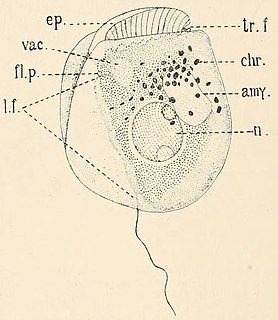Related Research Articles

Passalidae is a family of beetles known variously as "bessbugs", "bess beetles", "betsy beetles" or "horned passalus beetles". Nearly all of the 500-odd species are tropical; species found in North America are notable for their size, ranging from 20–43 mm, for having a single "horn" on the head, and for a form of social behavior unusual among beetles.

Mezia is a genus in the Malpighiaceae, a family of about 75 genera of flowering plants in the order Malpighiales. Mezia comprises 10 species of woody vines and lianas native to South America, with one species extending into Panama.
Xylocalyx is a genus of plants in the family Orobanchaceae.
Xylomoia is a genus of moths of the family Noctuidae.
Hypocoena is a genus of moths of the family Noctuidae.
Photedes is a genus of moths of the family Noctuidae.
Eophyllophila is a genus of flies in the family Tachinidae.

Amphidinium is a genus of dinoflagellates. The type for the genus is Amphidinium operculatum Claparède & Lachmann. The genus includes the species Amphidinium carterae which is used as a model organism.
Amauria is a genus of flowering plants in the daisy family described as a genus in 1844.

Spartina pectinata is a species of cordgrass known asprairie cordgrass, freshwater cordgrass, tall marshgrass, and sloughgrass. It is native to much of North America, including central and eastern Canada and most of the contiguous United States except for the southwestern and southeastern regions. Its distribution extends into Mexico. It is also present on other continents as an introduced species.

Hypoatherina is a genus of silversides in the family Atherinidae.
Leviprora inops, the Longhead flathead, is a species of flathead endemic to reefs in the coastal waters of southern Australia. This species grows to a length of 29.2 centimetres (11.5 in) SL. This species is the only known member of its genus.
The panatela silverside is a species of reef-dwelling silverside from the subfamily Atherinomorinae which is found in the southwest Pacific Ocean. This species grows to 11 cm (4.3 in) in total length and is of minor importance to commercial fisheries. This species is the only species in the genus Stenatherina, although some authorities place it in the genus Hypoatherina. This species was described by David Starr Jordan and Robert Earl Richardson as Atherina panatela with the type locality given as Calayan Island in the Philippines. The specific name is the Spanish word for a long, thin cigar and is presumed to be a reference to the elongated, slender body of this fish.
Alphatetraviridae is a family of viruses. Moths and butterflies serve as natural hosts. There are currently ten species in this family, divided among 2 genera. Infection outcome varies from unapparent to lethal.
Acacia inops is a shrub belonging to the genus Acacia and the subgenus Phyllodineae that is endemic to south western Australia.
Miana is a former genus of moths, including these species:
Photedes inops, common name Spartina borer moth, is a species of moth native to North America. The larvae are hosted on Spartina pectinata, apparently exclusively. It is listed as a species of special concern in the US state of Connecticut.
Photedes includens, the included cordgrass borer, is a species of cutworm or dart moth in the family Noctuidae. It is found in North America.
Photedes panatela, the northern cordgrass borer, is a species of cutworm or dart moth in the family Noctuidae.
Alistipes inops is a Gram-negative, non-spore-forming, rod-shaped, obligately anaerobic and non-motile bacterium from the genus of Alistipes which has been isolated from human faeces.
References
| This Hadeninae-related article is a stub. You can help Wikipedia by expanding it. |